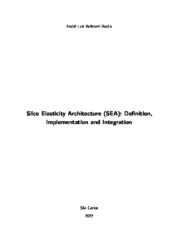| dc.contributor.author | Rocha, André Luiz Beltrami | |
| dc.date.accessioned | 2023-02-02T19:18:36Z | |
| dc.date.available | 2023-02-02T19:18:36Z | |
| dc.date.issued | 2022-02-14 | |
| dc.identifier.citation | ROCHA, André Luiz Beltrami. Slice Elasticity Architecture (SEA): definition, implementation and integration. 2022. Tese (Doutorado em Ciência da Computação) – Universidade Federal de São Carlos, São Carlos, 2022. Disponível em: https://repositorio.ufscar.br/handle/ufscar/17333. | * |
| dc.identifier.uri | https://repositorio.ufscar.br/handle/ufscar/17333 | |
| dc.description.abstract | Network slicing initiatives (e.g., Cloud Network Slicing, 5G Network Slicing) are being
widely studied by academia and industry as enablers for future networks like 5G and
6G, as well as verticals such as V2X, critical communications, augmented reality, and
others. Several challenges arise with this emerging concept, which needs to be solved to
further groundbreaking technologies. A significant challenge is slice elasticity, defined as
the capacity to grow or shrink slice resources (e.g., computing, networking, or storage). One
alternative to solve this challenge is providing a closed control loop (CCL) involving slice
monitoring, management, and orchestration. In addition, this CCL may be easily adapted
and coupled with most of the slicing initiatives of standardization bodies. In that sense,
this thesis proposes, implements, and integrates the Slice Elasticity Architecture (SEA), an
architecture to support a new business model called Slicing Elasticity as a Service (SlEaaS).
This new business model enables slice resource orchestration across a heterogeneous end-
to-end infrastructure that spans multiple administrative and technological domains in a
facilitated and automated way for tenants and slice providers. The SEA monitors slice
resources periodically, offers the policies/SLAs administration, and performs slice elasticity
operations autonomously when the predefined policy is violated to ensure the QoS of the
instantiated service. The SEA design is scalable and generic enough to support several
technologies transparently. The results demonstrate the SEA functionalities based on
scenarios of slice elasticity operations for computing and networking resources. | eng |
| dc.description.sponsorship | Outra | por |
| dc.description.sponsorship | Coordenação de Aperfeiçoamento de Pessoal de Nível Superior (CAPES) | por |
| dc.language.iso | eng | eng |
| dc.publisher | Universidade Federal de São Carlos | por |
| dc.rights | CC0 1.0 Universal | * |
| dc.rights.uri | http://creativecommons.org/publicdomain/zero/1.0/ | * |
| dc.subject | Slice elasticity | eng |
| dc.subject | Slice monitoring | eng |
| dc.subject | Slice orchestration | eng |
| dc.subject | Slice elasticity as a service | eng |
| dc.subject | CCL | eng |
| dc.subject | Cloud network slicing | eng |
| dc.subject | Elasticidade de slices | por |
| dc.subject | Monitoramento de slices | por |
| dc.subject | Orquestração de slices | por |
| dc.subject | Elasticidade de slices como serviço | por |
| dc.title | Slice Elasticity Architecture (SEA): definition, implementation and integration | eng |
| dc.title.alternative | Slice Elasticity Architecture (SEA): definição, implementação e integração | por |
| dc.type | Tese | por |
| dc.contributor.advisor1 | Verdi, Fábio Luciano | |
| dc.contributor.advisor1Lattes | http://lattes.cnpq.br/9143186843657940 | por |
| dc.description.resumo | Network slicing initiatives (e.g., Cloud Network Slicing, 5G Network Slicing) are being
widely studied by academia and industry as enablers for future networks like 5G and
6G, as well as verticals such as V2X, critical communications, augmented reality, and
others. Several challenges arise with this emerging concept, which needs to be solved to
further groundbreaking technologies. A significant challenge is slice elasticity, defined as
the capacity to grow or shrink slice resources (e.g., computing, networking, or storage). One
alternative to solve this challenge is providing a closed control loop (CCL) involving slice
monitoring, management, and orchestration. In addition, this CCL may be easily adapted
and coupled with most of the slicing initiatives of standardization bodies. In that sense,
this thesis proposes, implements, and integrates the Slice Elasticity Architecture (SEA), an
architecture to support a new business model called Slicing Elasticity as a Service (SlEaaS).
This new business model enables slice resource orchestration across a heterogeneous end-
to-end infrastructure that spans multiple administrative and technological domains in a
facilitated and automated way for tenants and slice providers. The SEA monitors slice
resources periodically, offers the policies/SLAs administration, and performs slice elasticity
operations autonomously when the predefined policy is violated to ensure the QoS of the
instantiated service. The SEA design is scalable and generic enough to support several
technologies transparently. The results demonstrate the SEA functionalities based on
scenarios of slice elasticity operations for computing and networking resources. | por |
| dc.publisher.initials | UFSCar | por |
| dc.publisher.program | Programa de Pós-Graduação em Ciência da Computação - PPGCC | por |
| dc.subject.cnpq | CIENCIAS EXATAS E DA TERRA::CIENCIA DA COMPUTACAO::SISTEMAS DE COMPUTACAO | por |
| dc.description.sponsorshipId | EU-Brazil Joint Call EUB-01-2017 | por |
| dc.publisher.address | Câmpus São Carlos | por |
| dc.contributor.authorlattes | http://lattes.cnpq.br/6413433791281709 | por |

